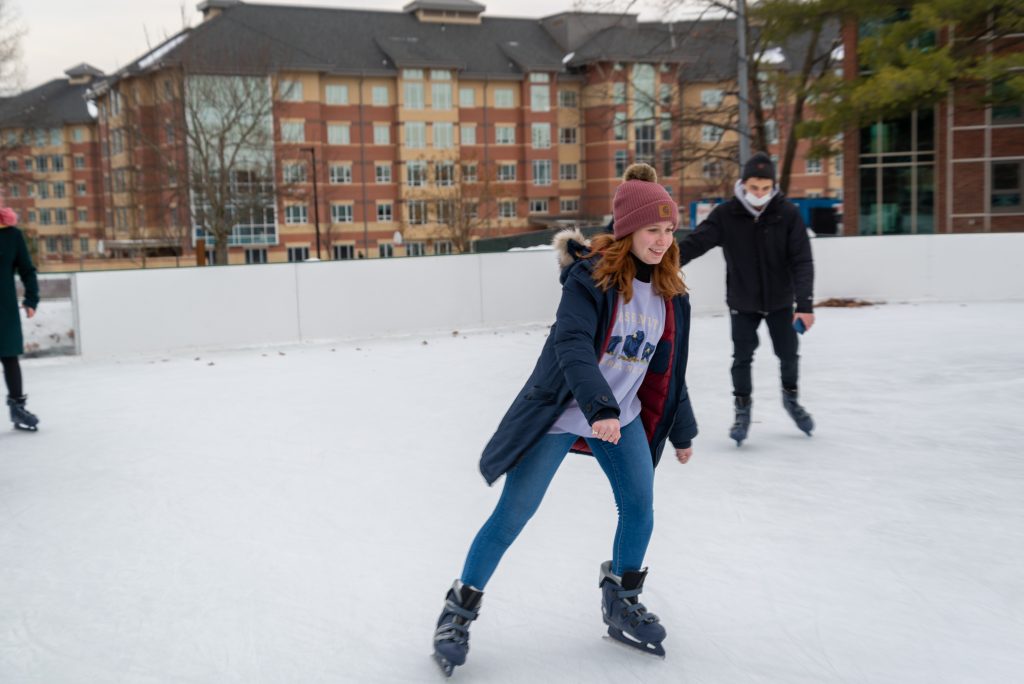Ice-skating. It looks so graceful and beautiful when the Olympians do it, but why is it so hard when you go ice-skating for the first time? If you are like me and recently tried ice-skating for the first time at Binghamton University’s free ice-skating rink for students (located between Whitney Hall and Old Johnson Hall) or have never gone skating before, then perhaps these upcoming tips will help you master the art of ice-skating.
Dress properly
There are a few things that you can do to help your skating before you set foot on the rink. First, make sure that you are dressed appropriately for the winter weather so that you do not get too cold. However, ice-skating is a physical activity, so it is a good idea to wear layers in case you get too hot or start to sweat a lot. Similarly, when receiving your ice skates (free rentals are available for students at BU’s ice rink), make sure to get the right size and tighten the straps so that they are neither too tight nor too loose. Skates can feel uncomfortable around your ankles at first, so consider wearing socks that are longer than your boots for warmth and comfort.
Start out slowly
Once you are ready to start ice-skating, you have to remember that you are not an Olympian (yet) and so it is important to be careful and take it slow. After shimmying yourself onto the rink, stay close to the wall because it does not bite and will be your friend when you lose your balance. Now that you have made it to the wall, it is time to learn about the basic motion of ice-skating.
The fundamentals
You are ready to start skating, but how does one even begin? The key is to shift your body weight from one foot to the other, waddling like a penguin while constantly maintaining your balance. As you do this, keep your feet shoulder-length apart from each other. It is also important to point your toes straight ahead or slightly out. And just like that, you have started skating! The rest of the tips in this article are more peripheral and should enhance the fundamentals.
Keep your eyes up
Trust me, it is very tempting to only look down and watch your feet while skating, but this is dangerous because you need to watch where you’re going. You never know when someone may swerve or fall in front of you, so it is crucial that you are aware of your surroundings beyond your feet.
Bend your knees
This advice is true for most athletic activities because bending your knees increases your stability. Bending your knees lowers your center of gravity, giving you more control over your body as you skate. It also just makes you feel more athletic, which is just as important as the science behind it.
Do not lean back
Another way to maintain your balance while skating is to lean forward, rather than backward. If you lean backward too much, you will likely fall onto your back, which is dangerous because it is harder to break that type of fall with your hands. Similarly, you should also keep your arms in front of you to both maintain balance and potentially break a fall.
Knowing how to stop
It is just as important to know how to stop when you start skating, as you can easily fall down or ram into a wall if you do not know how to stop your momentum. In order to stop, point your toes inward, your heels outward and finally push out on your heels. Doing this will slowly bring you to a safe stop and prevent you from crashing into a fellow skater.
Be patient
The last tip on this list is to be patient and not expect too much from yourself while first learning to skate. Watching the Olympics or hockey may make us think that skating is easy and natural, but it takes a lot of practice to get to that point. Do not get down on yourself if you struggle or fall down. What is important is that you always get back up.



